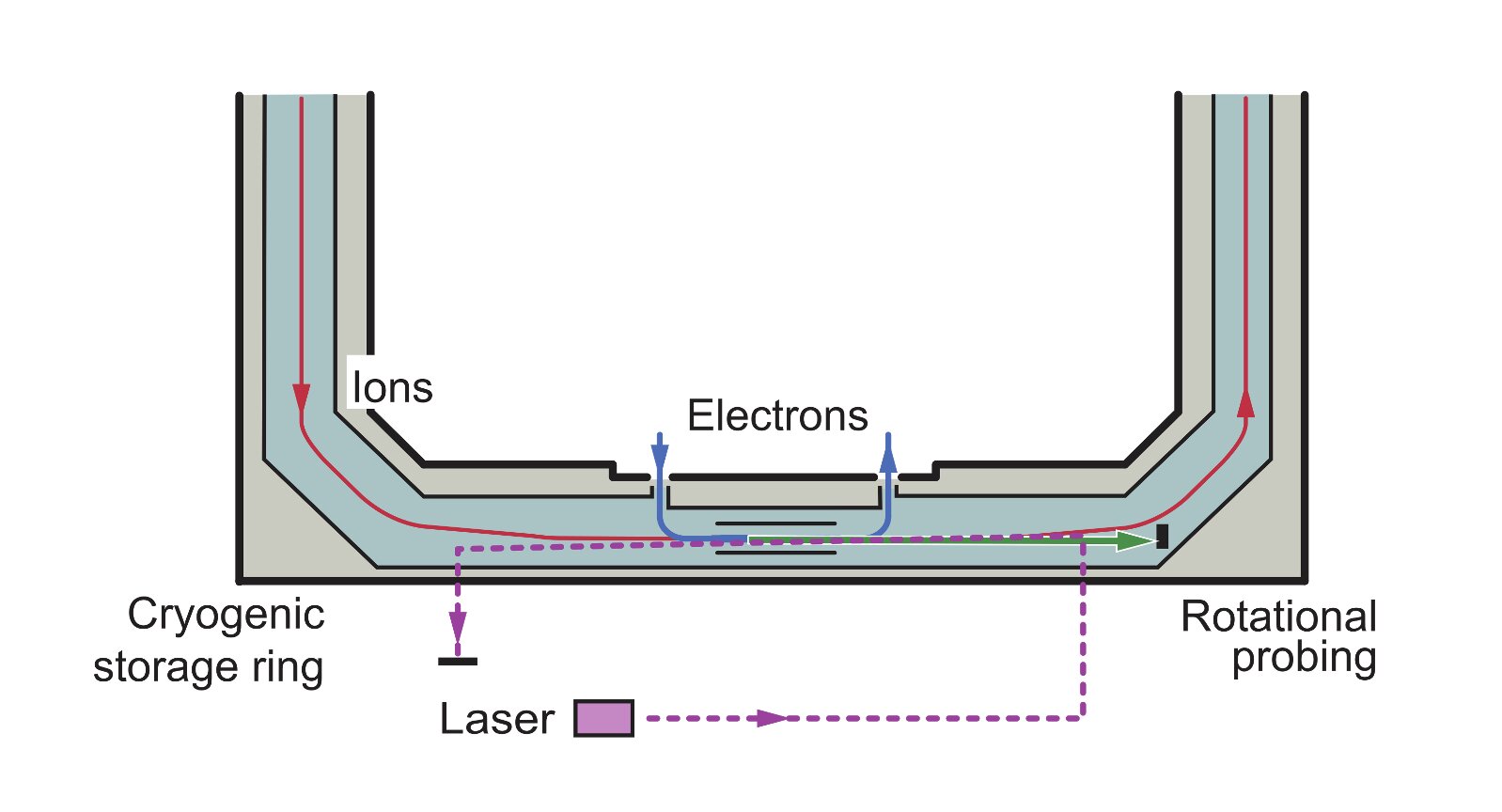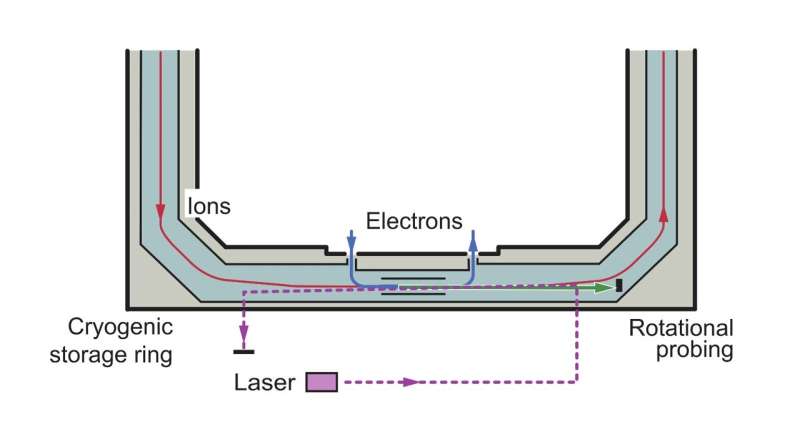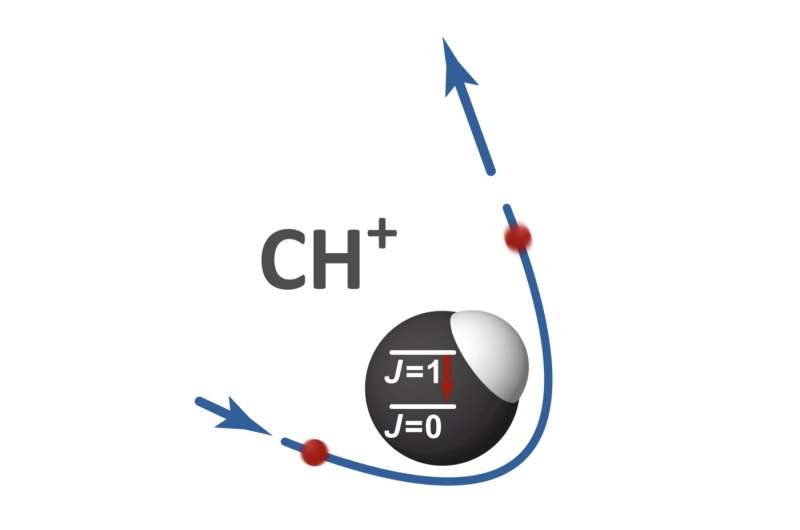

When it is free in cold space, a molecule will spontaneously cool down by slowing its rotation and losing rotational energy in quantum transitions. Physicists have shown that this rotational cooling process can be accelerated, slowed down and even inverted by the molecule’s collisions with surrounding particles.
Researchers at the Max-Planck Institute for Nuclear Physics in Germany and the Columbia Astrophysics Laboratory have recently carried out an experiment aimed at measuring the rate of quantum transitions caused by collisions between molecules and electrons. Their findings, published in Physical Review Letters, offer the first experimental evidence of this rate, which had previously only been theoretically estimated.
“When electrons and molecular ions are present in tenuous, ionized gases, the lowest quantum level populations of the molecules can be changed in a collision process,” Ábel Kálosi, one of the researchers who carried out the study, told Phys.org. “One example of this process is in interstellar clouds, where observations reveal molecules predominantly in their lowest quantum states. The attractive force between the negatively charged electrons and the positively charged molecular ions makes the process of electronic collisions particularly efficient.”
Physicists have been trying for many years to theoretically determine the strength with which a free electron interacts with a molecule during collisions and ultimately change the rotational state of the molecule. So far, however, their theoretical predictions had not been tested in an experimental setting.
“Until now, no measurement could determine the effectiveness of the rotational level changes for a given electron density and temperature,” Kálosi explained.
To collect this measurement, Kálosi and his colleagues brought isolated, charged molecules in close contact with electrons, at a temperature of approximately 25 Kelvin. This allowed them to experimentally test the theoretical hypotheses and predictions outlined in previous works.
In their experiment, the researchers used a cryogenic storage ring at the Max-Planck Institute for Nuclear Physics in Heidelberg, Germany, designed for species-selected molecular ion beams. In this ring, molecules move on a racetrack-like orbit in a cryogenic volume, which is emptied to a very high degree from any other background gas.
“In a cryogenic ring, the stored ions can radiatively cool towards the temperature of the walls of the ring, generating ions that are populated in their lowest few quantum levels,” Kálosi explained. “There are a handful of cryogenic storage rings recently built in a few countries, but our facility is the only one equipped with a specially designed electron beam that can be steered to enter in contact with the molecular ions. The ions are stored for many minutes in this ring, and a laser is used to interrogate the rotational energy of the molecular ions.”

By selecting a specific optical wavelength for their probing laser, the team could destroy a very small fraction of the stored ions, if their rotational energy level matched this wavelength. They then detected the fragments of the destroyed molecules to attain a so-called spectroscopy signal.
The team collected their measurements both in the presence and absence of electron collisions. This allowed them to detect level population changes under the cryogenic conditions set in their experiment.
“To measure the process of rotational state changing collisions, one must ensure that only the lowest rotational energy levels are populated in the molecular ions,” Kálosi said. “Hence, in a laboratory experiment, the molecular ions must be kept in an extremely cold volume, using cryogenic cooling to a temperature considerably lower than the usual near-300 Kelvin room temperature. In this volume, the molecules can be isolated from the omnipresent, infrared heat radiation of our environment.”
In their experiment, Kálosi and his colleagues were able to realize experimental conditions in which electron collisions dominated over radiative transitions. By using enough electrons, they could then collect a quantitative measurement of electronic collisions with CH+ molecular ions.
“We found rates for electron-induced rotational transitions compatible with previous theoretical predictions,” Kálosi said. “Our measurements provided the first experimental test of the existing theoretical predictions. We expect that future calculations will more strongly focus on the possible influence of electronic collisions on the lowest energy level populations in cold, isolated quantum systems.”
In addition to confirming theoretical predictions in an experimental setting for the first time, the recent work by this team of researchers could have important research implications. For instance, their findings suggest that measuring electron-induced rates of quantum-level changes could be crucial when analyzing faint signals of molecules in space detected by radio telescopes or the chemical reactivity in dilute and cold plasmas.
In the future, this paper could pave the way for new theoretical studies that consider the influence of electronic collisions on the occupation of rotational quantum levels in cold molecules more closely. This could help to single out cases in which electronic collisions have the strongest effects, potentially leading to more detailed experiments in this area.
“At the cryogenic storage ring, we plan to introduce more versatile laser techniques to probe the rotational energy levels for more diatomic and polyatomic molecular species,” Kálosi added. “This will pave the way for electronic collision studies with a large range of additional molecular ions. This type of laboratory measurements will continue to complement, especially observational astronomy, using the powerful observatories like the Atacama Large Millimeter/submillimeter Array in Chile.”
Collisions with electrons cool molecular ions
Ábel Kálosi et al, Laser Probing of the Rotational Cooling of Molecular Ions by Electron Collisions, Physical Review Letters (2022). DOI: 10.1103/PhysRevLett.128.183402
© 2022 Science X Network
Citation:
Using laser technology to measure the rotational cooling of molecular ions colliding with electrons (2022, June 1)
retrieved 1 June 2022
from https://phys.org/news/2022-06-laser-technology-rotational-cooling-molecular.html
This document is subject to copyright. Apart from any fair dealing for the purpose of private study or research, no
part may be reproduced without the written permission. The content is provided for information purposes only.